Cradle of Scotland
3 September - 31 December 2015
Hunterian Art Gallery
Admission free
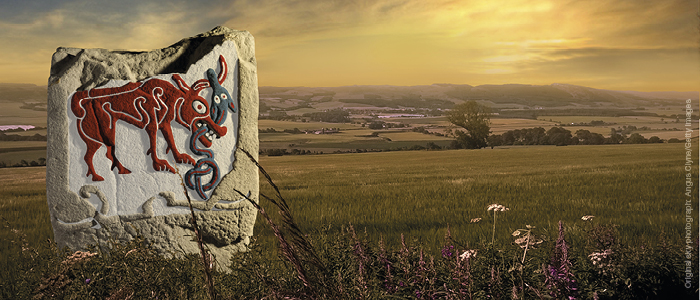
Introduction
Cradle of Scotland presents the results of 10 years work by the University of Glasgow’s Strathearn Environs and Royal Forteviot Project, known as SERF.
Led by a team of archaeologists from the University, the project explores the rich archaeological landscapes of Forteviot in Strathearn, Perthshire.
No place has a better claim to be the cradle of Scotland than Forteviot, where a Pictish royal palace stood alongside a huge prehistoric ceremonial complex.
Archaeology reveals the important story of Forteviot over three millennia using cropmarks, sculptures, buried structures and artefacts.
The exhibition explores the evolution of society from the loosely connected communities of early farmers in prehistory to the centralised kingdom of Alba (Gaelic for ‘Scotland’).
Iron Age hillforts, the clash between the Romans and Caledonians and the development of the Pictish kingdom complete this biography of a sacred landscape.
Cradle of Scotland is jointly curated by The Hunterian and Perth Museum and Art Gallery.
Prehistoric Forteviot
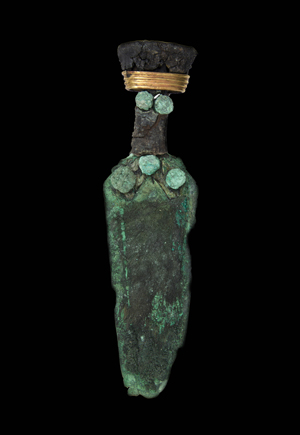 Forteviot was the focus for some of the most spectacular monuments of Neolithic Britain. Activity began in around 3000 BC and there was an almost continuous sequence of burials, building and burning until the start of the Iron Age in around 800BC.
Forteviot was the focus for some of the most spectacular monuments of Neolithic Britain. Activity began in around 3000 BC and there was an almost continuous sequence of burials, building and burning until the start of the Iron Age in around 800BC.
The earliest activity at Forteviot consisted of cremation burials, followed later by the construction of a massive palisaded enclosure, one of the largest in prehistoric Europe.
The sacred quality of Forteviot was subsequently enhanced by the construction of massive henges. Later burials marked by barrows would have served as focal points for subsequent burial for several generations.
This section also includes the reconstruction of a Bronze Age cist and displays an array of objects and organic materials excavated from it. Most significant is the gold decorated Forteviot Dagger, and a bouquet of meadowsweet - one of the earliest surviving floral tributes from a grave in Britain.
Iron Age Hillforts
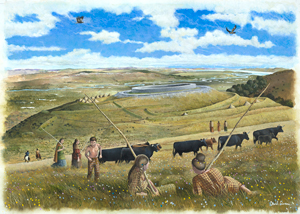 A dense concentration of hillforts has been found on the hills around Forteviot and excavation and field survey have lead to a better understanding of their function.
A dense concentration of hillforts has been found on the hills around Forteviot and excavation and field survey have lead to a better understanding of their function.
The hillforts were at their peak from the late Bronze Age (c. 1200 BC) until the late Iron Age (c. 200 BC) and before the SERF project had received limited investigation. Radiocarbon dating has revealed that earlier settlements were reused and replaced over time and became more complex.
The artefacts on display illustrate the long-lived nature of the hillforts and are mainly domestic items from daily life including simple undecorated pottery and utilitarian stone tools. Over time the axe has been one of the most enduring types of object and there are examples in stone, bronze and iron from hillforts in the area.
Caledonians and Romans
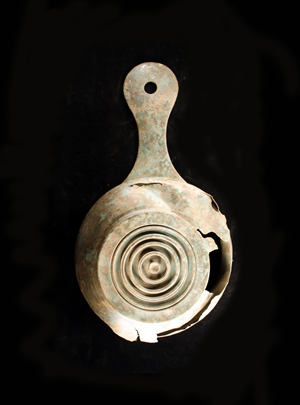 Contact with the Roman Empire from late in the 1st century AD led to dramatic developments in Iron Age Scotland, stimulating social change. It was this time of conflict and trade that gave birth to the Picts.
Contact with the Roman Empire from late in the 1st century AD led to dramatic developments in Iron Age Scotland, stimulating social change. It was this time of conflict and trade that gave birth to the Picts.
Imported Roman goods, including coins, have been discovered on a few sites which were typically marked by imposing large scale round houses and stone towers or brochs. The concentration of imported goods and imposing architecture suggests that brochs were occupied by a new social elite. This social development continued and saw chieftains replaced by kings, as Caledonians became Picts.
Some of the objects recovered by the 2013 excavation of Castle Craig broch are displayed here, including imported pottery and glass, Roman metal work and brooches and bangles.
Royal Forteviot
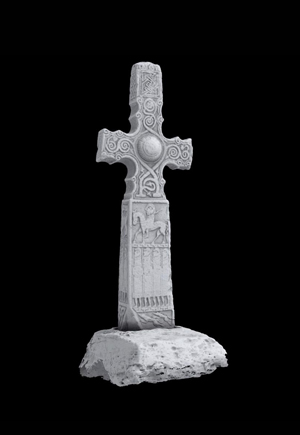 Forteviot was a royal residence of both the Pictish kings and the first kings of Alba. It was at its most important in the 9th century when it was the seat of the dynasty of king Kenneth mac Alpin.
Forteviot was a royal residence of both the Pictish kings and the first kings of Alba. It was at its most important in the 9th century when it was the seat of the dynasty of king Kenneth mac Alpin.
Forteviot formed the political and spiritual core of the Pictish kingdom which evolved into the medieval kingdom of Scots. It derived some of its authority from the ancient ceremonial landscape it was situated in and proclaimed this authority through its own monuments, including prominent burials and a concentration of high quality monumental sculpture. Surviving fragments, on display here, help us to understand developments in Pictish society between the 8th and 10th centuries.
Key objects include a 3D animation of Constantine’s Cross, the Forteviot Hand Bell, a reconstruction of the Forteviot Arch and the fragments of at least three other sculpted crosses found at Forteviot and Invermay.
Events
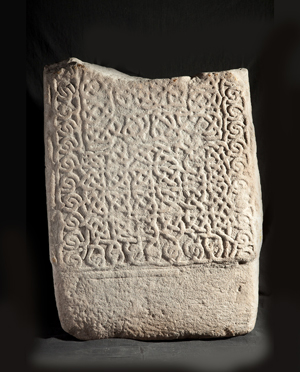 Cradle of Scotland Exhibition Tours
Cradle of Scotland Exhibition Tours
Free student led tours of the exhibition. Further details to follow.
Cradle of Scotland Family Fun
14 October 2015
12.00pm - 3.00pm
Hunterian Art Gallery
Join us for a journey through 5000 years of Scottish history. Our student volunteers will guide you from the ritual centres of Stone Age man, past Roman occupied Britain and all the way to to the Royal Palace of King Kenneth MacAlpin. Budding archaeologists can have a go at an archaeological dig and even examine some real ancient Scottish and Roman artefacts! Admission free and no booking required. Please note that there will be a brief break in activities at 1.00pm for a Cradle of Scotland lunchtime talk. This is a chance to hear all about the project from one of the students involved.
Cradle of Scotland Salon des Refusés
21 October 2015*
3.00pm – 5.00pm
Room 320 Gregory Building
Cradle of Scotland Pottery Workshop
11 November 2015*
3.00pm – 5.00pm
Room 320 Gregory Building
Cradle of Scotland Conversation Session
26 November 2015
5.30pm – 7.00pm
Hunterian Art Gallery
Cradle of Scotland Lithics Workshop
9 December 2015*
3.00pm – 5.00pm
Room 320 Gregory Building
Experience the Past Drop-in Activities
14 October, 15 November and 12 December 2015
12.00pm – 3.00pm
Hunterian Art Gallery
Free
Special student led drop-in activities for all the family inspired by the Cradle of Scotland exhibition.
Cradle of Scotland Open Studies Study Day
This day event puts Forteviot within its broader historical and archaeological context. For further information call 0141 330 1835.
*Please note that some dates may be subject to change.
Cradle of Scotland 10 Minute Talks
Wednesdays at 1.00pm
Hunterian Art Gallery
Free
16 September 2015
Serfing in Strathern
Professor Stephen Driscoll, University of Glasgow
23 September 2015
Kenneth Mac Alpin: First King of Scotland
Professor Dauvit Broun, University of Glasgow
30 September 2015
How to Rebuild a Hillfort
John Sanders, Simpson and Brown Architects
7 October 2015
Demise: why do major population centres fade and die out?
Professor Paul Bishop, University of Glasgow
14 October 2015
SERF: a student’s perspective
Jamie Barnes, University of Glasgow student
21 October 2015
How to Build a Hillfort
Dr Tessa Poller, University of Glasgow
28 October 2015
Neolithic Forteviot
Dr Kenneth Brophy, University of Glasgow
4 November 2015
Archaeobotany; People and Plants
Dr Jennifer Miller, York Archaeological Trust
11 November 2015
Title to be confirmed
Dr Steven Timoney, Perth College
18 November 2015
Unexpected finds from the Castle Craig broch
Dr Heather James, York Archaeological Trust
25 November 2015
Towers of the North…only? Castle Craig and Iron Age brochs as a Scotland-wide phenomenon
Dr Tanja Romankiewicz, University of Edinburgh
2 December 2015
Whose game is it anyway? Picts and Romans at play
Mark Hall, Perth Museum
Acknowledgements
 The SERF Project and this exhibition have received generous support from Museums Galleries Scotland (Strategic Investment Fund), Historic Scotland, the University of Glasgow, Perth Museum and Art Gallery, the Royal Commission on the Ancient and Historical Monuments of Scotland, the British Academy, the University of Aberdeen, the University of Chester, the University of Liverpool, Perth and Kinross Heritage Trust and the Society of Antiquaries of Scotland. Without out the participation of hundreds of students and volunteers and the co-operation of dozens of land owners and farmers the Forteviot story could not be told.
The SERF Project and this exhibition have received generous support from Museums Galleries Scotland (Strategic Investment Fund), Historic Scotland, the University of Glasgow, Perth Museum and Art Gallery, the Royal Commission on the Ancient and Historical Monuments of Scotland, the British Academy, the University of Aberdeen, the University of Chester, the University of Liverpool, Perth and Kinross Heritage Trust and the Society of Antiquaries of Scotland. Without out the participation of hundreds of students and volunteers and the co-operation of dozens of land owners and farmers the Forteviot story could not be told.
 Cradle of Scotland will move to Perth Museum and Art Gallery from 2 February – 26 June 2016. For further information about the exhibition and related events programme visit their website.
Cradle of Scotland will move to Perth Museum and Art Gallery from 2 February – 26 June 2016. For further information about the exhibition and related events programme visit their website.
All images © The Hunterian, University of Glasgow 2015 unless otherwise stated.

